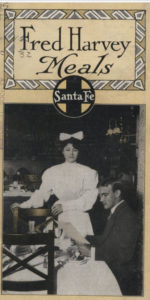 Some times we historical fiction writers get so locked into the old days we write about, we forget that our contemporaries might not have the foggiest notion of what we’re talking about.
Some times we historical fiction writers get so locked into the old days we write about, we forget that our contemporaries might not have the foggiest notion of what we’re talking about.
For instance, I’ve written a new short story called “Detectives’ Honeymoon.” And I’ve been promoting it with this blurb: “After resolving the mysteries of Mischief In March, Book 3 of the Calendar Mystery series, the newly wedded Daniel and Minty Price set off on their honeymoon. But due to a number of unforeseen circumstances, a Harvey Girl, and a would-be Sherlock Holmes, they come to fear they won’t have a honeymoon at all.” The “would-be Sherlock Holmes” still flies, but one of my Facebook friends asked me what a Harvey Girl was. So here’s a bit of history on suitable jobs for women in 1900 that ends with a description of a Harvey Girl.
Back in March 1900 when Mischief in March and “Detectives’ Honeymoon” take place, women still didn’t have many options for respectable employment outside the home. But still women did work. In Kansas City, with a population of 50,000 in 1900, for instance, 5,000 women worked outside the home. Here are some respectable jobs for women back then.
1) Quite a few worked in Kansas City’s burgeoning garment industry, which I used as the major setting for Fatal February, Book 2 of my Calendar Mystery series.
2) Many were educators, working as “schoolmarms” in one-room school houses in the area, though Mary Louise Barstow and Ada Brann founded their own school for girls in the Quality Hill area of Kansas City around 1884. (Their school has moved several times, but it still exists as a co-ed institution.)
3) Some women went into nursing. A few became doctors.
4) Many women worked outside the home as business girls in assorted capacities, part of typing pools for insurance companies, for instance. Trained stenographers like my heroine Minty Wilcox and my own great aunt Melicent Perkins who inspired her could demand top dollar free-lancing their skills.
5) Women worked in assorted retail establishments around Kansas City like Emery, Bird, Thayer Dry Goods where Minty took her younger siblings to shop for shoes in January Jinx, Book 1 of my Calendar Mystery series.
6) Some women even owned their own businesses, a millinery shop or dressmaker’s, for two instances. Miss Ellen Schooley helped run the family stationer’s shop where Minty Wilcox goes for office supplies.
7) By 1900, most telephone operators in Kansas City and everywhere else in the world for that matter were women, young men having been found too rude and impatient for the work. Mrs. Flora Snodgrass, who lives at the Wilcox home as a boarder along with her husband Lemuel, is a telephone operator.
8) Although Kate Warne worked undercover in the South for Allen Pinkerton during the Civil War, by 1900 very few women worked in law enforcement. Mr. George Mathison, the manager of Price Investigations and Minty Wilcox’s boss, is firmly against female operatives in all three books of my Calendar Mystery series so far.
9) But by 1900 being a Harvey Girl had become a most suitable job for a woman, mostly because of the very high standards Fred Harvey held for his employees including the waitresses who served meals in the restaurants he established along the Atchison, Topeka, and the Santa Fe Railroad. Before 1878, when Harvey took over a lunchroom above the train station in Topeka, Kansas, a traveler on railroads beyond Kansas City faced a vast food desert hundreds of miles long. If you didn’t bring your own food for the trip to Denver, for instance, or you did, but you ran out because the train was delayed, you would be very hungry by the time you reached your destination. Or you could risk food poisoning at a whistle stop along the way. By 1900, though, you would find a Harvey House, a top-grade eating establishment every hundred miles along the line. At a Harvey House you could count on getting a fine meal including anything you’d expect in the best New York City establishment served by young, efficient, intelligent, absolutely clean and tidy Harvey Girls of impeccable character. And you got good value for your seventy-five cents dinner, for Harvey Houses were known for slicing their pies into four pieces instead of the usual six.
 If you’d like to learn more about the Harvey Girls, read Lesley Poling-Kempes’ lively book The Harvey Girls: Women Who Opened the West. You might also enjoy The Harvey Girls film with Judy Garland. And by all means, please get your very own copy of “Detectives’ Honeymoon,” the latest installment in my Calendar Mystery series, now available for only $0.99 at wwww.amazon.com/dp/B07D89JXN.
If you’d like to learn more about the Harvey Girls, read Lesley Poling-Kempes’ lively book The Harvey Girls: Women Who Opened the West. You might also enjoy The Harvey Girls film with Judy Garland. And by all means, please get your very own copy of “Detectives’ Honeymoon,” the latest installment in my Calendar Mystery series, now available for only $0.99 at wwww.amazon.com/dp/B07D89JXN.
You can find other books and stories in my Calendar Mystery series at www.amazon.com/Juliet-Kincaid/e/B00DB4HWRG
